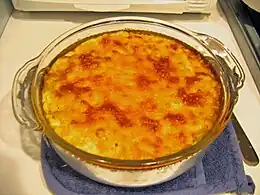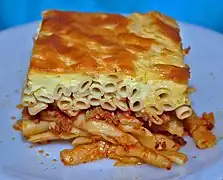
Macaroni cheese pie is a casserole dish based on baked macaroni and cheese.[1][2] Primary ingredients may include elbow macaroni, cheese, and milk.
Preparation

Typical ingredients in macaroni pie include macaroni pasta, cheese, milk, butter, flour, salt, pepper and various spices.[2] Additional ingredients sometimes used include onion and bread crumbs.[2] Other ingredients may also be used. It can be prepared as a low-fat dish using reduced fat cheese and skim milk.[2] Some versions, such as those in Scotland, are prepared using a pie crust,[3] while others are not.[4] It may be served sliced into wedges.[5]
By region
In the Caribbean, macaroni pie is typically prepared without using a pie crust.[6] In the Caribbean, it is sometimes consumed cold, which may be referred to as "Caribbean style".[6]
Barbados
Macaroni pie is a popular dish in Barbados, where it is commonly consumed as a Main or Side Dish along with fish or meat.[6] It is sometimes prepared as a spicy dish, using spices such as black pepper and hot sauces.[6]
Scotland
In Scotland, macaroni pie is prepared by filling a Scotch pie shell with macaroni and cheese and baking it.[3][7][8] Greggs sold it in Scotland, but stopped doing so in June 2015, which spurred an online campaign and petition for the company to return the dish.[8] Several prominent Scottish politicians signed the petition, including main party leaders Nicola Sturgeon, Ruth Davidson and Kezia Dugdale.[8]
Trinidad and Tobago
The dish is very popular in Trinidad and Tobago and is often available as a common dish at lunches and dinners.[1] It has been described as a staple food in Tobago.[9] Cheddar cheese, a key ingredient in the dish, was brought to Trinidad by English peoples.[1] It is sometimes served as a side dish accompanied with stewed meats.[1]
United States
In the United States, macaroni pie has been and sometimes still is referred to as "baked macaroni and cheese".[2][10] It is a part of the cuisine of the Southern United States.[11] In the United States during the mid-1900s, the word "spaghetti" was typically used to refer to macaroni, and spaghetti noodles were used to prepare macaroni pie during this time period.[11] An American recipe from 1870 includes grated ham as an ingredient in the dish, and also calls for the meat from squirrels, birds or wild ducks.[12] An American recipe from 1892 includes pork and ham in the dish's preparation.[13]
Similar dishes
The Finnish macaroni casserole or makaro(o)nilaatikko is a popular dish made with elbow pasta and egg-and-milk mixture, and baked until it sets. Often sautéed minced meat (and optionally onion) is added, thus creating a lihamakaronilaatikko (literally, meat-macaroni casserole). The casserole may be topped before baking with breadcrumbs and grated cheese and/or knobs of butter, to form a crunchy crust.[14] Makaronilaatikko is typically served with tomato ketchup and pickles such as gherkins.
Pastitsio is a type of macaroni pie in Greek cuisine prepared using elbow macaroni noodles and various additional ingredients.[15]
In Italian cuisine the macaroni pie (Italian: Pasticcio (or Timballo) di maccheroni) is a traditional dish in several cities, with a long tradition originating from the pastizzi prepared by the chefs active in the Italian courts of the Renaissance: the most well known, filled with pigeon meat and truffles, comes from Ferrara,[16] while also Rome (whose pasticcio, filled with chicken innards and topped with cream, has a clear Renaissance origin) Naples and Sicily have their own version.[17][18] The Sicilian Timballo has been immortalised by Luchino Visconti in his movie Il Gattopardo.[18]
See also
References
- 1 2 3 4 Ganeshram, R.; Vellotti, J. P. (2005). Sweet Hands: Island Cooking from Trinidad & Tobago. The Hippocrene cookbook library. Hippocrene Books. p. 98. ISBN 978-0-7818-1125-5. Retrieved May 9, 2016.
- 1 2 3 4 5 Rombauer, I. S.; Becker, M. R.; Becker, E.; Guarnaschelli, M. (1997). JOC All New Rev. – 1997. Scribner. p. 320. ISBN 978-0-684-81870-2. Retrieved May 9, 2016.
- 1 2 Bartynek, Shirley (July 2, 2015). "Free macaroni pie for every reader in today's Hamilton Advertiser". Daily Record. Retrieved May 9, 2016.
- ↑ Rundell, M. E. K. (1844). A New System of Domestic Cookery: Founded Upon Principles of Economy, and Adapted to the Use of Private Families. Carey and Hart. p. 98. Retrieved May 9, 2016.
- ↑ DellaVecchia, D. (2012). The Diary of a Mad Chef: "A Collection of Culinary Treasures and Short Stories". Trafford Publishing. p. 149. ISBN 978-1-4669-4302-5. Retrieved May 9, 2016.
- 1 2 3 4 Spieler, M.; Barnhurst, N. (2013). Macaroni & Cheese. Chronicle Books LLC. pp. 104–105. ISBN 978-1-4521-2507-7. Retrieved May 9, 2016.
- ↑ "Eight Scottish foods that they're too scared to serve anywhere else". Herald Scotland. May 27, 2015. Retrieved May 9, 2016.
- 1 2 3 Wilkie, Stephen (June 25, 2015). "Fury as Greggs says bye-bye macaroni pie". Express.co.uk. Retrieved May 9, 2016.
- ↑ O'Donnell, K. (2013). Tobago Adventure Guide. Hunter Publishing, Incorporated. p. pt117. ISBN 978-1-55650-127-2. Retrieved May 9, 2016.
- ↑ Fowler, D. (2014). Beans, Greens & Sweet Georgia Peaches: The Southern Way of Cooking Fruits and Vegetables. Globe Pequot Press. p. 72. ISBN 978-1-4930-1410-1. Retrieved May 9, 2016.
- 1 2 Dupree, N. (2012). Mastering the Art of Southern Cooking. Gibbs Smith. p. pt654. ISBN 978-1-4236-2316-8. Retrieved May 9, 2016.
- ↑ Elliott, S. A. (1870). Mrs. Elliott's Housewife: Containing Practical Receipts in Cookery. Hurd & Houghton. p. 79. Retrieved May 9, 2016.
- ↑ Taylor, M. (1892). Letters to a Young Housekeeper. Cooking in America Series. Applewood Books. p. 94. ISBN 978-1-4290-1095-5.
- ↑ "Makaroonilaatikko - Traditional Finnish Macaroni Bake". Cake Crumbs & Beach Sand. Retrieved June 23, 2018.
- ↑ Joachim, D. (2005). The Church Supper Cookbook: A Special Collection of Over 400 Potluck Recipes from Families and Churches Across the Country. Rodale. p. 25. ISBN 978-1-59486-202-1. Retrieved May 9, 2016.
- ↑ Savoldi, Giovanna (1977). Cucina Emiliana e Romagnola (in Italian). Firenze: Edizioni del Riccio. p. 41.
- ↑ Boni, Ada (1983) [1930]. La Cucina Romana (in Italian). Roma: Newton Compton Editori. p. 201.
- 1 2 Cardella, Giovanni. "Timballo del Gattopardo". Ricette di Sicilia. Retrieved May 20, 2016.
